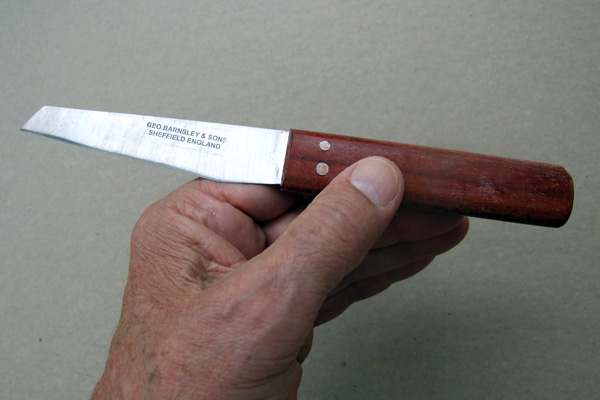
My cobbler's knife, with home-made soft leather sheath
I have chosen to use the title cobbler's for the knife, and apologise to those who would prefer some other word. I am sure there are others, in addition to those listed in the sub-head. The apology is doubly required, since most of my tasks for this knife are ~ I suspect ~ quite unlike those used by a cobbler or cordwainer. I describe here the structure of a knife, as used by cobblers ~ probably for centuries.

Blades can be of various length. The visible length of blade, illustrated, is 11cm. It is sharpened along one edge ~ the lower one in this picture. Both cutting edge and back edges are straight. The tip is also cut straight across when supplied. Hence the name clip knife. The blunt, angled, tip is typical for these knives. The reflected light in the photo suggests that both edges are shop. The lower one is the sharply ground edge.
The end of this illustrated knife of mine has been ground back to give slightly rounded corners ~ I felt it to be more user-friendly. It is certainly less likely to scratch or get caught during everyday handling. I use it a lot for jobs requiring the full length of the blade. I have no need for the usual sharpness of the point. I never use the tip of the blade on this knife, preferring to grab my sliding-blade pocket-knife, which has a very acute angled ~ easily replaced ~ point for jobs needing a sharp tip. Keen eyed observers may also notice that the leather sheath is unfinished. I will get round to it one day. (Actually...I was not happy with the shape, and resolved to start over...one day...)
The blades of these knives is always well inset into the handle, and always securely riveted ~ here with three rivets passing through the handle.
The handle is usually made of hard wearing wood, and of rounded rectangular section. This gives greater control than a circular sectioned handle. Frequently the handle is described as being redwood. This should be read as red wood, not Redwood. Redwood trees, a tropical hardwood, have been protected for some years because of over use. It is now illegal to use Redwood without strict licence provisions. Tool-handles do not count as a justified use - there are many alternatives.


Sometimes the quality of the wood used, and its finish, is an indication of the quality of the steel and manufacturer, but not always. At one stage the best quality knives always had Rosewood handles. It is possible that the better handle is there to justify a price increase beyond that necessary for general use.
The handle illustrated at the page top has a slight burnish from general wear. Frequently handles are supplied in a rougher finish, often using beechwood.
I rounded off the shoulder and ends of this knife to make it more pleasant to feel and see. The end grains are usually left simply squared-off and unfinished. It would add to the cost to undertake this embellishment for everyone.
The knife is a strong, general purpose, tool, designed for hard work and wear. To work well it must be sharp, and kept sharp. I suspect a cobbler would sharpen it once or twice a day ~ depending on the quality of the steel used.
Most craftspeople can happily do without one of these in the toobox. I would suggest waiting until you have a need for one before buying one, although it might be worth dropping hints at birthday or Christmas time. For most 'general' jobs I use a simple sliding-blade knife with disposable blades. If the blade is fairly new the blades of such pocket-knives extend to a useful length for jobs requiring the longer blade [121407]. Such disposable blades are sometimes too flexible to be easy to use. The cobbler's knife is very stiff, and this property is desireable for some uses. I use it frequently as a sharp paper knife. At such a time the knife-action is far removed from any that a cobbler would use. The
I demonstrate the knife in use in several ways ~
~ Using as a sharp paper knife [121970]
~ Hacking-up cardboard boxes [114910]
~ When cobbled-cutting goes wrong [125438]
~ Results of a cobble-cutting task [119688]
